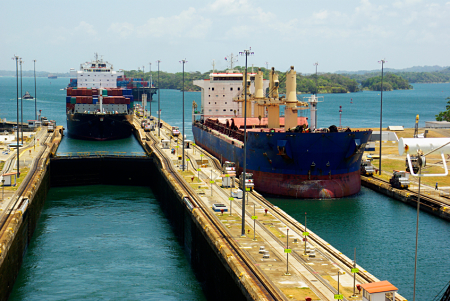Panama Canal expansion will affect U.S. trucking industry, report says
The 2015 expansion of the Panama Canal will have an effect on U.S. trucking, according to a report recently released by U.S. DOT’s Maritime Administration (MARAD).
The study focuses on the canal expansion’s impacts on ports, waterways and intermodal freight systems.
The Panama Canal Expansion Study, the first of a two-part study, found the integration of Post-Panamax vessels into U.S. trade lanes will have substantial implications for the nation’s shippers, ports and surface freight corridors, particularly along the East Coast, Gulf Coast and inland states located east of the Mississippi River.
In addition, more cost-effective service generated by the larger vessels could improve the ability of some U.S. exports, like grain, coal, petroleum products and liquefied natural gas, to compete in global markets.
“The Panama Canal expansion is great news for American competitiveness,” said Will Sawyer, analyst with Rabobank’s Food & Agribusiness Research and Advisory group. “Whereas nearly 80 percent of U.S. grain exports went through the U.S. Gulf a decade ago, demand growth in Southeast Asia and increased efficiencies at U.S Pacific Northwest ports have reduced that market share to between 60 and 65 percent currently. The Canal expansion and resulting decreases in shipment cost and time will greatly improve the cost position of the U.S. vis-à-vis Brazil, Argentina and other grain exporting countries in Eastern Europe.
“The expansion is also positive for U.S. Gulf ports,” Sawyer continued, “as the doubling of the draw area in Minnesota, Iowa and Missouri will allow U.S. Gulf ports to take back much of the export share lost to the Pacific Northwest over the past 15 years. Most of this shift will be driven by increased corn exports through the U.S. Gulf, reversing the recent trend.”
The study found that with more cargo arriving and departing on a single ship, the demand for truck pickup and delivery will increase as well.
“Terminals will need to increase the number of trucks they can efficiently handle each hour or each day by expanding physical gate facilities, speeding up processing through existing facilities (for example, with improved information technology and automation) and/or increasing their hours of operations,” the report says. “If not carefully managed, peaks in truck traffic may contribute to excessive congestion, emissions or other adverse impacts in areas around the port.”
The study indicates ports will transition from the existing 5,000 TEU (Twenty-foot equivalent unit) vessels to vessels as large as 13,000 TEUs with the additional canal capacity.
According to the study, major factors will shape the impact of the canal expansion on U.S. trade. The factors are as follows:
- More concentrated U.S. port calls. Use of larger ships will increase the volume of containers that must be moved at each port call for those larger vessels. This will likely lead to fewer and more concentrated ship calls at larger ports for any given service, especially for vessel deployments serving the Northeast Asia – U.S. East/ Gulf Coast trade. Fewer calls by larger ships would lead to higher peak loads and tend to favor ports that have greater capacity in container handling, storage and movement to inland destinations.
- Readiness of U.S. ports and related infrastructure. Readiness includes navigational channel depth and height (air draft) restrictions, terminal handling and storage capabilities, rail connectivity and capacity and inland transportation systems (specifically,intermodal rail and “last mile” port and terminal connections).
- Use of foreign container transshipment ports. The extent to which U.S. ports and others invest to improve vessel handling capacity and more concentrated cargo volumes, and move the cargo inland, could influence whether shipping companies decide to make greater use of Caribbean or Panamanian container transshipment ports.
- Development of marine highways. Port capacity constraints and more concentrated port calls could lead to greater use of marine highway services to move containers via water between larger and smaller U.S. ports. As with foreign transshipment, the handling and transport costs as well as the externalities (e.g., landside traffic congestion) of competing modes are a significant factor in determining the viability of a marine highway as a competitive option.
The Obama administration believes the canal expansion will be a boon for American business, bringing more jobs and development to U.S. ports. “Modernizing the canal is a consequential investment in the future of the United States of America,’’ said Vice President Joe Biden during a November visit to the canal. “It protects Panama’s unique place in the world economy as a new generation of massive container ships and tankers hits the high seas.”






